DENTAL PROSTHETICS
How many teeth do you have missing? We have a solution for every problem.WHEN ONLY ONE TOOTH IS MISSING
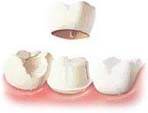
PORCELAIN CROWN ON A SINGLE TOOTH
If the tooth is missing a visible part, but has a healthy root, it is possible to restore it with a crown. This can be a porcelain fused to metal crown (standard), zircon-based, or or made out of pure ceramic (press).
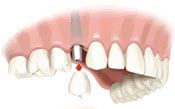
PORCELAIN CROWN ON A DENTAL IMPLANT
This is the best way of compensation because we do not have to prepare adjacent teeth like when we do a dental bridge. The implant is installed into the jawbone, and after a period of integration is ready for receiving an abutment and a crown. Installing the implant prevents:
– Bone deterioration (atrophy)
– Tilting of the adjacent teeth
– The emergence of the teeth on the opposite jaw.
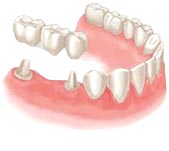
THREE UNIT PORCELAIN BRIDGE
This procedure usually involves reshaping of two teeth that will act as a bridge support. The bridge is then cemented to the carrier and cannot be removed by the patient (fixed prosthetics). This prevents:
– Tilting of adjacent teeth
– The emergence of the teeth on the opposite jaw
– Loosening of the remaining teeth
– Excessive wear of remaining teeth
WHEN SEVERAL TEETH IS MISSING
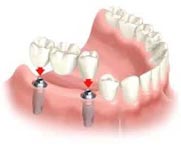
THE BRIDGE ON DENTAL IMPLANTS
If you are missing several teeth in a row, it is possible to insert implants and assemble a bridge on them, instead of having separate crowns. For example, two implants can easily carry 3-4 teeth.

PORCELAIN BRIDGE ON TEETH
This implies grinding two or more “carrier” teeth. The bridge is cemented onto those teeth and it compensates for missing teeth. The bridge framework can be made out of metal alloy, gold, titanium or zirconium.
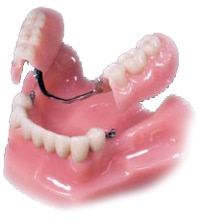
COMBINED FIXED AND REMOVABLE PROSTHESIS
This consists of a fixed (usually front teeth with a crown on them) and a mobile part (partial dentures). The dentures are clasped to the bridge with special hidden joint connections which ensure stability of the mobile part and high aesthetics.
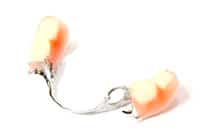
PARTIAL DENTURE
Simple and very common partial denture is a mobile solution that is attached to the remaining teeth with external clasps. Aesthetically and statically speaking, they are not as valuable as a combined solutions, but its price is more favorable.
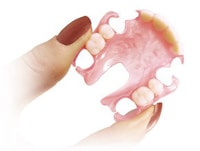
FLEXIBLE DENTURE
They are characterized by elasticity which makes this particular prosthesis almost impossible to break. The clasp can be made in the same colour of your gums or teeth, which makes them aesthetically pleasing.
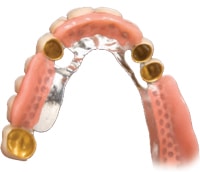
“REMOVABLE BRIDGE”
They are sometimes called “the removable bridge” and are made in those cases when there aren’t enough teeth to provide the retention of a classic bridge. The teeth are usually covered with a gold crown, which is used for achieving reception and retention of the prosthesis.
WHEN ALL YOUR TEETH ARE MISSING
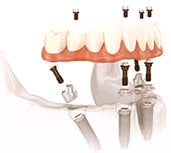
ALL ON FOUR & ALL ON SIX
This procedure implies the insertion of 4 -6 implants and an immediate fixed prosthetics same day. This innovative technique is ideal in cases where a patient has insufficient bone in the posterior jaw area. The implants are inserted into the front part of the jaw, where there is better skeletal quality and quantity, which provides stability. The temporary bridge is made out of acrylate and is attached to the implants using special screws. The entire procedure is done in one day. After 6 months, the bridge is replaced with a definitive one.
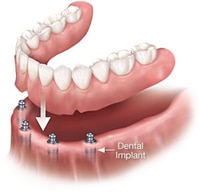
OVERDENTURE ON 2-4 IMPLANTS
Four implants are placed in the upper jaw, and in the lower one 2-4 implants with special abutments in the form of clips to which the denture is fixed. This type of prosthesis doesn’t have a palate part, which makes it very pleasant for the patient. The aesthetics of this work is very high, and hygiene is simple to maintain, since the dentures can be removed.
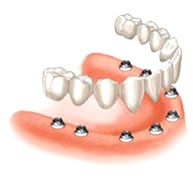
THE BRIDGE ON DENTAL IMPLANTS
This is a fixed prosthetic solution of the highest quality. It is made on at least 6 dental implants, and may have a metal or zirconium framework. Very often the surgical phase requires bone augmentation (sinus lift).
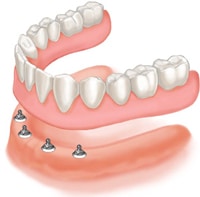
OVERDENTURE AND MINI- IMPLANTS
In the case of a highly resorbed (thin) jaw, mini-implants are installed, and they are used to accept and stabilise dentures. If the patient already has a satisfactory prosthesis, it is possible to set it on the implants. Mini – implants are often placed through the gums (flapless) without any cuts or stitches, which makes the recovery much easier, without any swelling and pain.
